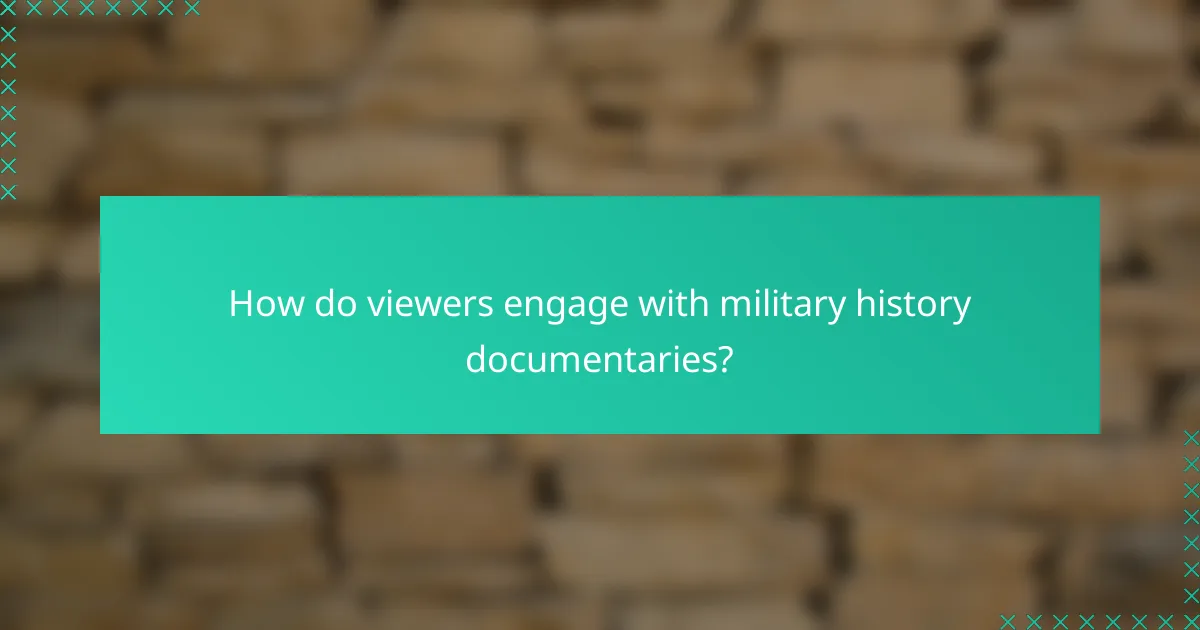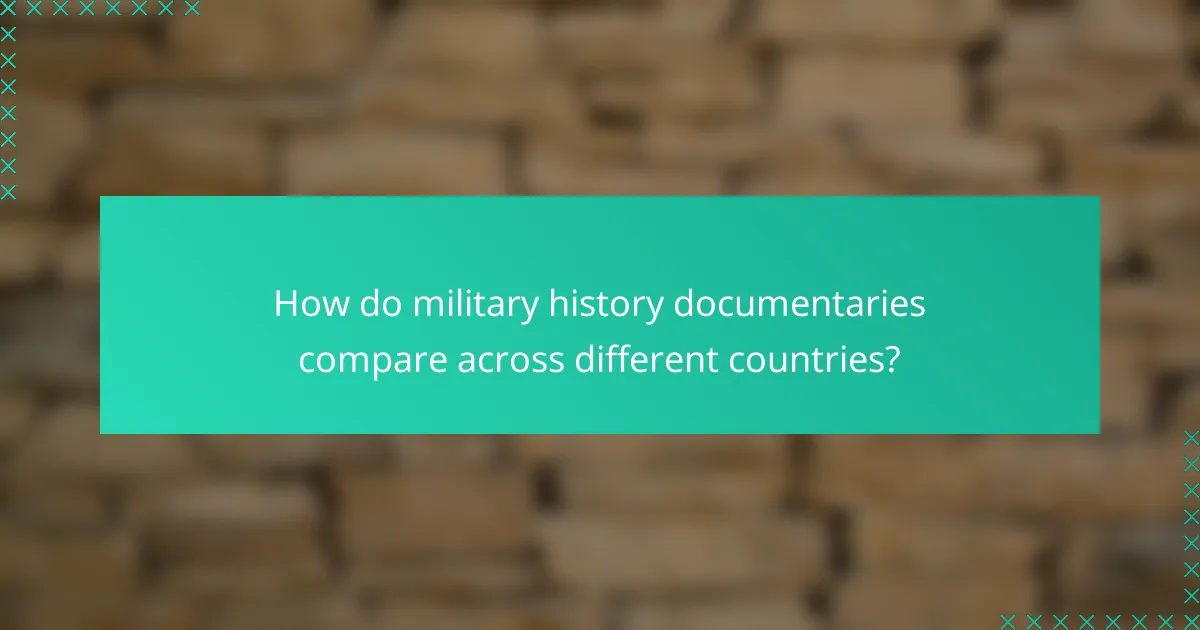Military history documentaries play a crucial role in shaping public perception by framing narratives around significant historical events and conflicts. Through compelling storytelling and visual presentation, these films influence how audiences understand military actions, their motivations, and the resulting consequences, ultimately impacting collective memory and societal opinion.

How do military history documentaries shape public perception?
Military history documentaries significantly influence public perception by framing narratives around historical events and conflicts. They shape how audiences understand military actions, the motivations behind them, and their consequences, often impacting collective memory and opinion.
Influence on historical understanding
Military history documentaries play a crucial role in shaping historical understanding by presenting curated narratives that highlight specific events and perspectives. They often emphasize particular themes, such as heroism or tragedy, which can alter viewers’ interpretations of history.
For example, a documentary focusing on a specific battle may glorify the strategies employed by one side while downplaying the complexities and consequences faced by the opposing forces. This selective storytelling can lead to a skewed perception of historical facts.
Impact on national identity
These documentaries can reinforce or reshape national identity by portraying military history in a way that aligns with national values and pride. They often highlight moments of national triumph, which can foster a sense of unity and patriotism among viewers.
Conversely, they may also confront uncomfortable truths about a nation’s past, prompting discussions about accountability and reconciliation. This duality can significantly influence how citizens view their country’s role in global history.
Role in shaping opinions on military conflicts
Military history documentaries can shape public opinions on ongoing or past military conflicts by providing context and analysis that may not be present in mainstream media. They often explore the motivations behind wars, the experiences of soldiers, and the impact on civilian populations.
By presenting various viewpoints, these documentaries can challenge prevailing narratives and encourage critical thinking among viewers. However, they can also perpetuate biases if they favor one perspective over others, leading to polarized opinions on military actions.

What are the most popular military history documentaries?
Some of the most popular military history documentaries include Ken Burns’ “The Civil War,” “World War II in HD,” and “Restrepo.” These films have significantly influenced public perception of historical events through their compelling storytelling and visual presentation.
Ken Burns’ The Civil War
Ken Burns’ “The Civil War” is a landmark documentary series that aired in the early 1990s. It combines archival photographs, expert commentary, and personal letters to provide a comprehensive view of the American Civil War.
This documentary is notable for its emotional depth and narrative style, which helps viewers connect with the historical figures involved. It has been praised for its thorough research and has become a reference point for understanding the complexities of the war.
World War II in HD
“World War II in HD” is a documentary series that utilizes restored color footage to present the events of World War II in a new light. This series stands out for its immersive visual experience, allowing viewers to see the war from multiple perspectives.
The series includes personal accounts from veterans, enhancing the storytelling with firsthand experiences. It effectively conveys the scale and impact of the war, making it accessible to a broad audience.
Restrepo
“Restrepo” is a documentary that follows a platoon of U.S. soldiers deployed in Afghanistan’s Korengal Valley. It provides an unfiltered look at the realities of combat, focusing on the soldiers’ experiences and the challenges they face.
This film is unique in its raw portrayal of military life, emphasizing the emotional and psychological toll of war. It has received critical acclaim for its authenticity and has sparked discussions about the nature of modern warfare.

How do viewers engage with military history documentaries?
Viewers engage with military history documentaries through various platforms, discussions, and demographic trends. Their interest often reflects broader societal perceptions of military events and historical narratives.
Viewing demographics
The audience for military history documentaries tends to skew older, with many viewers aged 35 and above. This demographic often includes veterans, history enthusiasts, and individuals with a personal connection to military service.
Gender representation is also notable, as men typically make up a larger portion of the audience. However, there is a growing interest among women, particularly in documentaries that highlight women’s roles in military history.
Online streaming trends
Online streaming platforms have significantly influenced how viewers access military history documentaries. Services like Netflix, Amazon Prime, and specialized channels offer a wide range of content, making it easier for audiences to find and watch these films at their convenience.
Viewership patterns indicate that binge-watching is common, with many viewers consuming multiple episodes in one sitting. This trend suggests that engaging storytelling and high production values are crucial for retaining viewer interest.
Social media discussions
Social media plays a vital role in shaping public perception of military history documentaries. Platforms like Twitter, Facebook, and Reddit facilitate discussions where viewers share insights, critiques, and recommendations, enhancing community engagement.
Hashtags related to specific documentaries often trend, allowing for broader conversations about historical interpretations and the impact of military events. Engaging with these discussions can deepen viewers’ understanding and appreciation of the subject matter.

What criteria influence the selection of military history documentaries?
The selection of military history documentaries is influenced by various criteria, including awards, critical reviews, and audience ratings. These factors help determine the perceived quality and relevance of a documentary, guiding viewers in their choices.
Documentary awards and recognition
Awards and recognition play a significant role in the selection of military history documentaries. Documentaries that receive prestigious accolades, such as the Emmy or Academy Awards, often gain increased visibility and credibility. This recognition can attract viewers who prioritize quality content.
Additionally, film festivals that focus on historical or military themes can highlight noteworthy documentaries, further influencing public perception. For example, documentaries that win awards at festivals like the Sundance Film Festival may be more likely to be selected by audiences seeking engaging and well-crafted narratives.
Critical reviews and ratings
Critical reviews and ratings are crucial in shaping the public’s perception of military history documentaries. Reviews from reputable sources can provide insights into the documentary’s accuracy, storytelling, and production quality. High ratings on platforms like Rotten Tomatoes or IMDb can signal to potential viewers that a documentary is worth watching.
It is important for viewers to consider both critic and audience ratings, as they can sometimes differ. A documentary with a high critic score but a low audience rating may indicate a niche appeal, while a film with strong audience support might resonate more broadly. Checking multiple sources for reviews can help in making a well-informed selection.

How do military history documentaries compare across different countries?
Military history documentaries vary significantly across countries in terms of focus, narrative style, and public reception. These differences often reflect national perspectives on historical events and the cultural context in which they are produced.
US vs UK military documentaries
US military documentaries typically emphasize a narrative of heroism and technological superiority, often highlighting individual stories of valor. In contrast, UK documentaries may take a more critical approach, exploring the complexities of warfare and its consequences on society.
For example, US productions like “Band of Brothers” focus on personal sacrifice and camaraderie, while UK series such as “The World at War” provide a broader historical context, examining the impact of war on civilian life. This distinction influences how audiences perceive their military history.
European perspectives on military history
European military history documentaries often prioritize a multi-faceted view of conflicts, addressing the political, social, and economic ramifications of wars. Countries like Germany and France tend to include discussions on the moral implications of their military actions, reflecting a more introspective approach.
Documentaries from these nations may feature interviews with historians and survivors, providing a platform for diverse viewpoints. This contrasts with more nationalistic narratives found in some other regions, encouraging viewers to consider the broader implications of military history.

What emerging trends are shaping military history documentaries?
Emerging trends in military history documentaries are increasingly focused on immersive technologies, interactive formats, and highlighting diverse perspectives. These innovations are transforming how audiences engage with historical narratives and understand military events.
Virtual reality experiences
Virtual reality (VR) experiences are revolutionizing military history documentaries by allowing viewers to step into pivotal moments. Through VR, audiences can explore battlefields, interact with historical figures, and gain a deeper emotional connection to events. This immersive approach can enhance understanding and retention of complex historical contexts.
For example, VR applications can recreate famous battles, enabling users to experience the environment and challenges faced by soldiers. As technology advances, the cost of creating these experiences is decreasing, making them more accessible to documentary filmmakers.
Interactive storytelling
Interactive storytelling in military history documentaries invites viewers to engage actively with the content. This trend allows audiences to make choices that affect the narrative, fostering a personal connection to the material. Such formats can include branching storylines or decision-making scenarios that reflect historical dilemmas faced by military leaders.
Platforms like interactive websites or mobile apps can enhance traditional documentaries by providing additional layers of information, such as maps, timelines, and personal accounts. This engagement can lead to a more profound understanding of the complexities of military history.
Focus on underrepresented narratives
There is a growing emphasis on underrepresented narratives in military history documentaries, which seeks to include voices and stories that have been historically marginalized. This trend aims to provide a more comprehensive view of military conflicts by highlighting the experiences of women, minorities, and non-combatants.
Documentaries that focus on these narratives can challenge traditional perspectives and encourage discussions about the broader implications of war. By showcasing diverse experiences, filmmakers can foster empathy and understanding among viewers, enriching the overall historical discourse.


